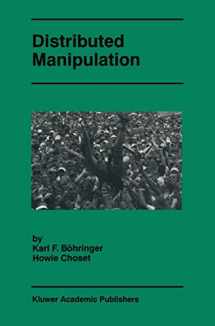
Distributed Manipulation
ISBN-13:
9780792377283
ISBN-10:
0792377281
Edition:
2000
Author:
Howie Choset, Karl F. Böhringer
Publication date:
2000
Publisher:
Springer
Format:
Hardcover
269 pages
FREE US shipping
Book details
ISBN-13:
9780792377283
ISBN-10:
0792377281
Edition:
2000
Author:
Howie Choset, Karl F. Böhringer
Publication date:
2000
Publisher:
Springer
Format:
Hardcover
269 pages
Summary
Distributed Manipulation (ISBN-13: 9780792377283 and ISBN-10: 0792377281), written by authors
Howie Choset, Karl F. Böhringer, was published by Springer in 2000.
With an overall rating of 3.5 stars, it's a notable title among other
AI & Machine Learning
(Robotics, Hardware & DIY, Civil & Environmental, Engineering, Electrical & Electronics, Mechanical, Computer Science) books. You can easily purchase or rent Distributed Manipulation (Hardcover) from BooksRun,
along with many other new and used
AI & Machine Learning
books
and textbooks.
And, if you're looking to sell your copy, our current buyback offer is $0.3.
Description
Distributed manipulation effects motion on objects through a large number of points of contact. The primary benefit of distributed manipulators is that many small inexpensive mechanisms can move and transport large heavy objects. In fact, each individual component is simple, but their combined effect is quite powerful. Furthermore, distributed manipulators are fault-tolerant because if one component breaks, the other components can compensate for the failure and the whole system can still perform its task. Finally, distributed manipulators can perform a variety of tasks in parallel. Distributed manipulation can be performed by many types of mechanisms at different scales. Due to the recent advances of MEMS (micro-electro-mechanical system) technology, it has become feasible to quickly manufacture distributed micro-manipulators at low cost. One such system is an actuator array where hundreds of micro-scaled actuators transport and manipulate small objects that rest on them. Macroscopic versions of the actuator array have also been developed and analyzed. Another form of distributed manipulation is derived from a vibrating plate, and teams of mobile robots have been used to herd large objects into desired locations. There are many fundamental issues involved in distributed manipulation. Since a distributed manipulator has many actuators, distributed control strategies must be considered to effectively manipulate objects. A basic understanding of contact analysis between the actuators and object must also be considered. When each actuator in the array has a sensor, distributed sensing presents some basic research challenges. Distributed computation and communication are key issues to enable the successful deployment of distributed manipulators into use. Finally, the trade-off in centralized and de-centralized approaches in all of these algorithms must be investigated.


We would LOVE it if you could help us and other readers by reviewing the book
Book review

Congratulations! We have received your book review.
{user}
{createdAt}
by {truncated_author}


